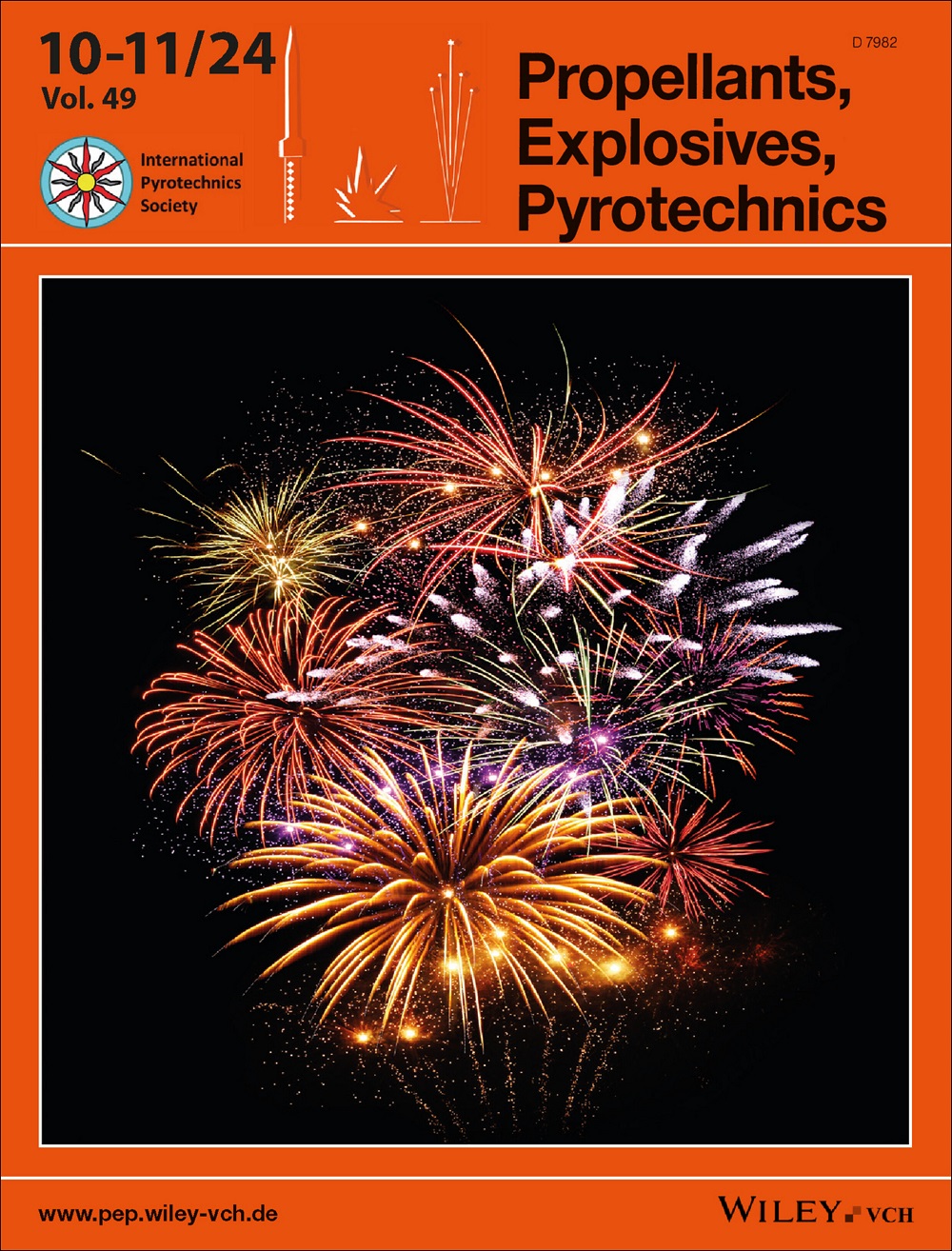爆炸荷载下结构性反应材料圆筒产生的异性爆破
IF 2
4区 工程技术
Q3 CHEMISTRY, APPLIED
引用次数: 0
摘要
本文将结构反应材料(SRM)圆筒视为致密金属能量系统的一个极限案例,其中的金属颗粒混合物被固结到理论上的最大密度(不包括孔隙率),从而同时具有高能量密度和机械强度。实验研究了内径 103 毫米的 SRM 筒形装药的动态破碎和自由场爆炸,其壁厚在金属与炸药质量比 M/C=1.3 至 4.0 的范围内变化。在爆炸装药情况下,SRM 弹筒产生的碎片尺寸分布分为两组:尺寸在 102 μm 及以下的细碎片和尺寸在 100-101 mm 之间的粗碎片。爆炸冲击诱发反应(DSIR)是由不断扩大的高浓度细小碎片云补充能量,以增强初级爆炸的传播,而粗大碎片则形成高速、高浓度的金属动量流,穿过火球和爆炸前沿,对附近的结构造成总冲力负荷。来自高速粗SRM碎片的次级碎片的快速撞击诱发反应(IIR)进一步增强了反射爆炸荷载,或在碎片穿透结构时产生较高的内部爆炸压力。独特的异质爆炸的上述显著特征在近场范围内有效耦合。本文章由计算机程序翻译,如有差异,请以英文原文为准。

Hetero-blast from a structural reactive material cylinder under explosive loading
A structural reactive material (SRM) cylinder is considered here as a limiting case of a dense metallic energetic system in which a mixture of metal particles is consolidated to the theoretical maximum density excluding porosity, to possess both high energy density and mechanical strength. Dynamic fragmentation and free-field explosion of a 103 mm inner diameter SRM cylinder charge is experimentally studied, with a wall thickness varying in a range of metal-to-explosive mass ratio M/C=1.3 to 4.0. Under explosive loading, the SRM cylinder produces a designated fragment size distribution divided into two groups: fine fragments with sizes on the order of 102 μm and below, and coarse fragments with sizes on the order ranging between 100-101 mm. Prompt detonation shock-induced reaction (DSIR) of the expanding cloud of high-concentration fine fragments supplements the energy to enhance the primary blast as it propagates, while the coarse fragments form a high-speed, high-concentration metal momentum flux crossing the fireball and blast front to contribute to the total impulse loading to a nearby structure. Rapid impact-induced reaction (IIR) of the secondary fragments from high-speed coarse SRM fragments further enhances the reflected blast loading or generates a high interior explosion pressure as fragments perforate into the structure. The above distinctive characteristics of a unique hetero-blast are coupled effectively in the near-field range.
求助全文
通过发布文献求助,成功后即可免费获取论文全文。
去求助
来源期刊

Propellants, Explosives, Pyrotechnics
工程技术-工程:化工
CiteScore
4.20
自引率
16.70%
发文量
235
审稿时长
2.7 months
期刊介绍:
Propellants, Explosives, Pyrotechnics (PEP) is an international, peer-reviewed journal containing Full Papers, Short Communications, critical Reviews, as well as details of forthcoming meetings and book reviews concerned with the research, development and production in relation to propellants, explosives, and pyrotechnics for all applications. Being the official journal of the International Pyrotechnics Society, PEP is a vital medium and the state-of-the-art forum for the exchange of science and technology in energetic materials. PEP is published 12 times a year.
PEP is devoted to advancing the science, technology and engineering elements in the storage and manipulation of chemical energy, specifically in propellants, explosives and pyrotechnics. Articles should provide scientific context, articulate impact, and be generally applicable to the energetic materials and wider scientific community. PEP is not a defense journal and does not feature the weaponization of materials and related systems or include information that would aid in the development or utilization of improvised explosive systems, e.g., synthesis routes to terrorist explosives.
 求助内容:
求助内容: 应助结果提醒方式:
应助结果提醒方式:


